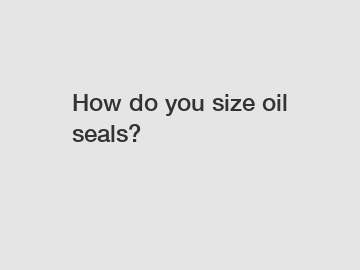How do you size oil seals?
How do you size oil seals? The size of oil seals can be determined through careful measurements and calculations using specific engineering standards. This process involves considering several factors to ensure proper fitting and functioning of the oil seal in a given application. In this article, we will explore the steps involved in sizing oil seals and discuss the significance and impact of accurate measurements.
To determine the size of an oil seal, the following steps are typically followed:
1. Identify the shaft diameter: Measure the diameter of the shaft on which the oil seal will be installed. This measurement is critical as it determines the size of the inner diameter of the oil seal.

2. Determine the bore diameter: The bore diameter is the measurement of the housing or bore in which the oil seal will fit. It is important to accurately measure the bore diameter to ensure a proper fit for the oil seal.
3. Consider the seal type and design: Oil seals come in various types and designs, such as lip seals, radial shaft seals, and axial shaft seals. Each type has its own specific requirements for sizing. Factors such as lip material, spring tension, and sealing lip design must be taken into account when selecting the appropriate oil seal.
4. Calculate the appropriate size: Using the shaft and bore diameter measurements, along with the specific requirements of the seal type, the appropriate size can be calculated. This calculation considers factors such as interference fit, compression of the seal lip, and allowance for thermal expansion and lubricant film thickness.
Accurate sizing of oil seals is crucial for several reasons. A properly sized oil seal ensures effective sealing of lubricants and prevents leakage, which can lead to equipment failure and costly repairs. Incorrectly sized oil seals can result in seal lip damage, excessive friction, and premature wear. By achieving the right fit, the oil seal can effectively maintain a barrier between internal and external environments, protecting the components and reducing the chances of contamination.
In addition to proper functioning, accurately sized oil seals contribute to the overall reliability and efficiency of the equipment. They improve the equipment's lifespan, reduce maintenance requirements, and optimize performance. By using the appropriate size, the oil seal can better withstand extreme temperatures, pressure differentials, and chemical exposure, ensuring reliable operation of the machinery.
In conclusion, sizing oil seals involves careful measurements and calculations to determine the appropriate size for a specific application. Accurate sizing is crucial to ensure effective sealing, prevent leaks, and optimize the overall reliability and efficiency of the equipment. It is important to consider factors such as shaft and bore diameter, seal type and design, and various engineering standards to achieve the desired results. By correctly sizing oil seals, potential issues can be avoided, leading to cost savings and improved operational performance.
Want more information on china differential oilseal manufacturer, green tc rubber oil seal china, nbr rubber parts for sealing company? Feel free to contact us.


